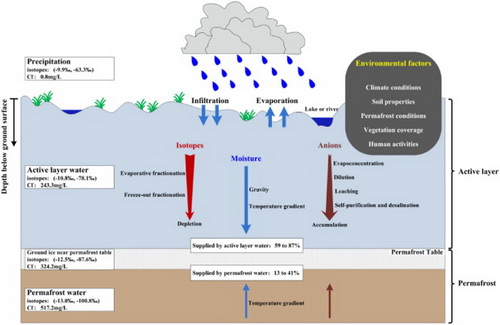Scientists Reveal Hydrochemical Characteristics of Ground Ice in the Qinghai-Tibet Plateau
Updatetime:2018-04-25From:
【Enlarge】【Reduce】
Ground ice is a distinctive feature of permafrost terrain and is also an important hydrological reservoir and a proxy index of past climates, which were sensitive to climate change. Ground ice hydrochemistry reflects hydrological and geochemical cycling during the freeze-thaw process.
However, few studies have examined the hydrochemistry of ground ice in permafrost-affected regions, particularly in the active layer and the underlying permafrost layer. Therefore, it is important to understand the characteristics of ground ice hydrochemistry under a warming climate.
Recently, scientists from the Northwest Institute of Eco-Environment and Resources of Chinese Academy of Sciences, together with their colleagues from Lanzhou University and Gansu Desert Control Research Institute, analyze the spatial variations and controls of ground ice hydrochemistry in permafrost regions on the Qinghai-Tibet Plateau (QTP) using data from nine soil profiles, and systematically illustrate the sources and the moisture and salt migration of ground ice in the context of permafrost degradation.
Results demonstrate that climate conditions, soil properties, vegetation coverage, permafrost conditions, and human activities combined to influence the variations of soil water chemistry. Soil moisture, air temperature, and active layer thickness were the major influencing factors.
In addition, clay soil may impede salt migration due to its semipermeable nature. The vertical distribution of hydrochemistry is an approach for studying the soil moisture-salt migration during the freeze-thaw processes.
Results also indicate that soil hydrochemistry in permafrost regions is important in biogeochemical cycling, and may affect the freshwater resource utilization and ecological functioning of soils, lakes, and rivers.
The study objectives were to examine the spatial variation of ground ice hydrochemistry on the QTP and to determine the influence of environmental factors on ground ice chemistry.
The result would be expected to enhance our understanding of ground ice origins and the moisture and salt migration pathways under a warming climate. Besides, this study could be useful in developing process-based permafrost hydrologic models.
This research has been published on the Science of The Total Environment in an article entitled “Hydrochemical characteristics of ground ice in permafrost regions of the Qinghai-Tibet Plateau”.

The conceptual diagram of the sources and the moisture and salt migration of ground ice in the permafrost regions of the central QTP. (Image by WU Tonghua)
Contact
WU Tonghua
Email: thuawu@lzb.ac.cn
State Key Laboratory of Cryospheric Science, Northwest Institute of Eco-Environment and Resources, Chinese Academy of Sciences, Lanzhou 730000, China.
Appendix




